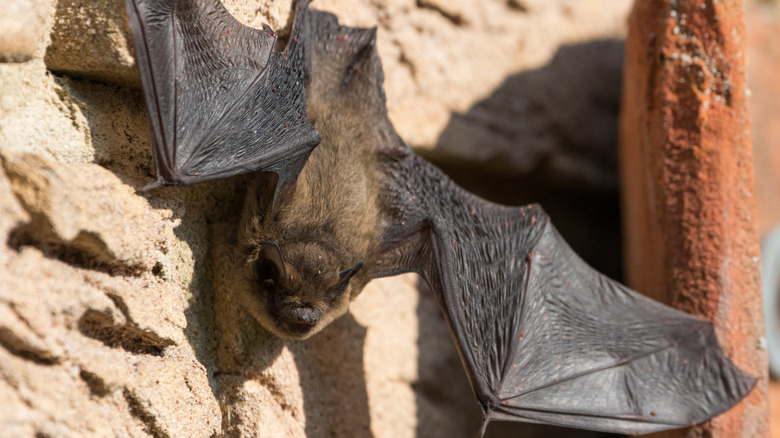The First Thing You Should Do After A Bat Bite
We all experience bug bites or the occasional nip from a cat or dog, but it's not often you hear about someone getting bit by a bat. Every year, health officials answer as many as 175 reports of mass bat exposures across the country, according to HealthDay News. By definition, mass bat exposure pertains to gatherings in which more than 10 individuals came in contact with a bat, putting them at potential risk for rabies.
Contracted through the saliva of an infected animal, rabies is a virus that progresses into a deadly infection (via Mayo Clinic). Early symptoms of infection often resemble the flu but can advance into hallucinations, fever, agitation, vomiting, difficulty swallowing, hyperactivity, excessive salivation, partial paralysis, and more. The U.S. Centers for Disease Control and Prevention (CDC) reports that with the exception of Hawaii, rabid bats have been found across all other U.S. states. As the leading cause of rabies death across the country, bat bites warrant immediate medical attention to determine if a rabies vaccine may be necessary.
While you won't be able to distinguish a rabid bat from an uninfected bat on sight, there are signs that can indicate the animal may be ill. Bats are nocturnal mammals. Therefore, the CDC notes that bats seen during the day or bats that are struggling to fly could possibly be infected. While the majority of bats are not rabid, here's what you'll want to do first if you suspect you've been bitten by a bat.
3 important steps to take following a bat bite
A bat bite, scratch, or any contact involving the mammal's saliva or other bodily matter requires medical attention (via CDC) — particularly if the matter has entered the nose, mouth, eyes, or an open wound. If you're not sure as to whether or not you've been bitten, be sure to consult with a healthcare professional. The first thing you should do following a bat bite is clean the affected area with warm water and soap for at least ten minutes, per Three Rivers Hospital. Next, promptly seek emergency medical care.
Thirdly, try to capture the bat in a bucket or can with a secure lid (via Three Rivers Hospital). The bat's brain matter may be required for rabies testing. Use caution when attempting to secure the animal. It is advised to use leather gloves, tongs, or a net to keep yourself protected. Alternatively, the CDC suggests approaching the bat with a box. Once trapped underneath, slide a sturdy piece of cardboard underneath the box to keep the bat inside. Fasten the cardboard to the box with tape and puncture air holes through the top. Animal control, public health agencies, or wildlife conservation centers can also offer assistance. Always err on the side of caution when it comes to bat exposure. Their bite marks can be tiny, so always speak to a public health official or healthcare provider to determine your risk level and whether rabies vaccination may be needed.


